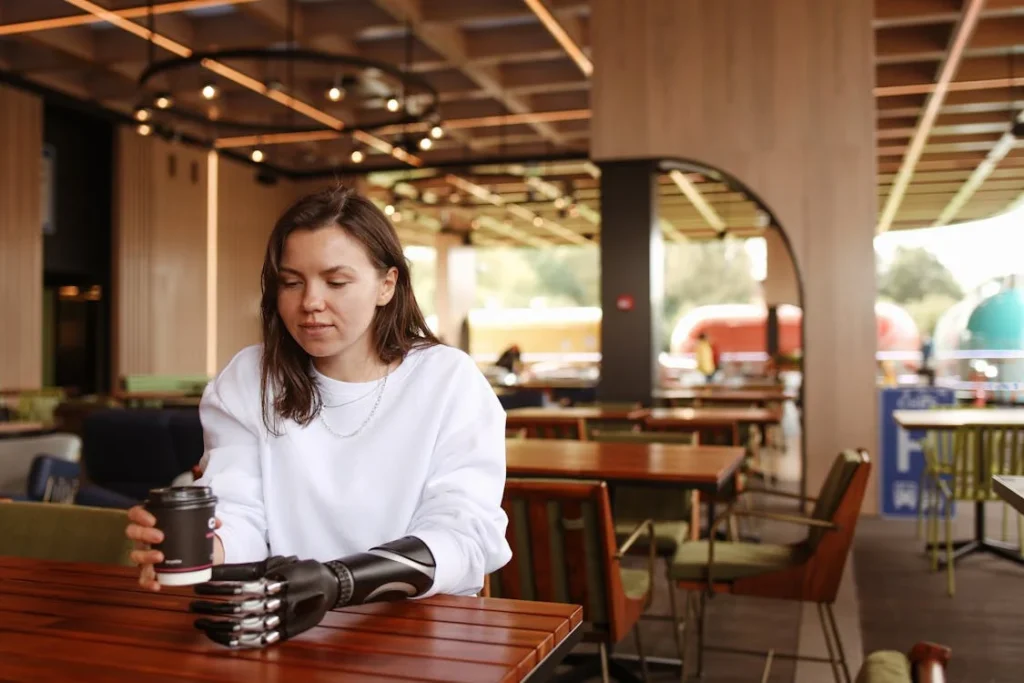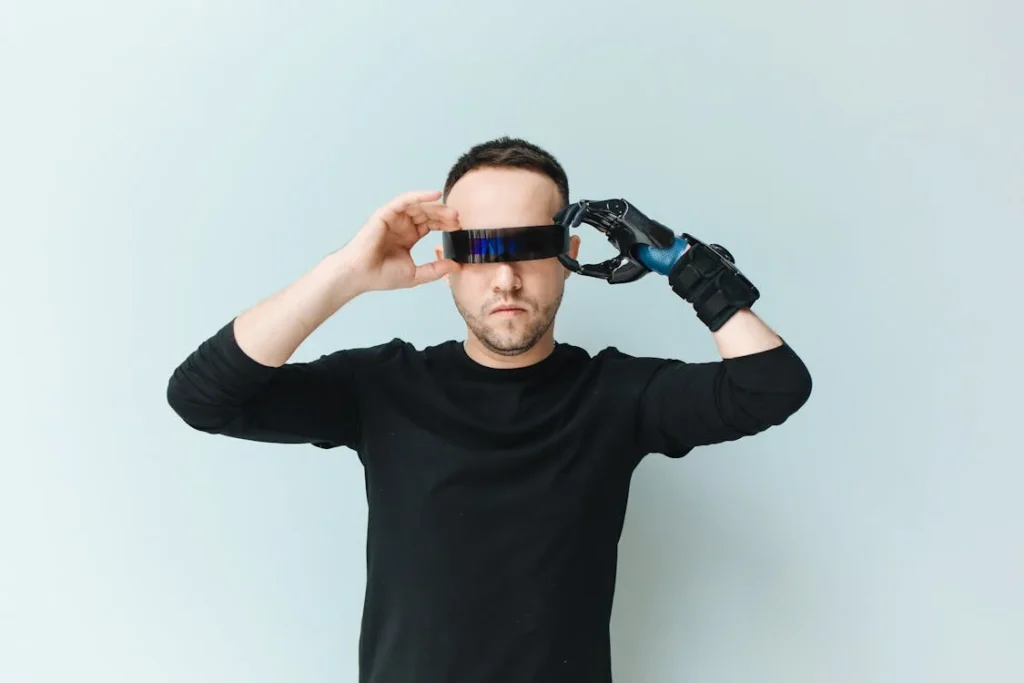For many people living with diabetes, life becomes a constant balancing act—watching blood sugar, avoiding infections, managing foot care, and staying on top of health check-ups. But when diabetes leads to amputation, the journey becomes even more complex. It’s not just about healing anymore—it’s about rebuilding the ability to walk, work, and live fully again.
That’s where timely prosthesis fitting comes in. For diabetic amputees, the window for successful rehabilitation is small, and any delay can cause long-term problems. But getting fitted with a prosthetic limb isn’t always easy for them. There are special medical concerns, emotional hurdles, and system-level gaps that make their path harder than most.
At Robobionics, we’ve worked closely with diabetic patients across India—both in big cities and rural towns. And we’ve seen how the right prosthesis, fitted at the right time, can restore not just mobility but confidence and purpose. That’s why we created this guide.

Why Diabetic Amputees Need a Different Approach
The Healing Process Is Slower—and Riskier
When someone without diabetes loses a limb, the body typically begins to heal in a predictable way. With proper care, the wound starts closing, swelling reduces, and within a few weeks, the person is usually ready to begin planning for prosthetic fitting. But for people with diabetes, healing doesn’t follow that same path.
High blood sugar affects blood vessels and nerves. That means wounds heal slowly, infections are harder to fight, and sometimes even small injuries can become serious problems. After an amputation, the surgical site may remain open longer. In some cases, wounds re-open or develop ulcers, especially if pressure is not managed properly. Because of poor circulation, even good surgical stitches can struggle to hold.
This makes timing tricky. If the prosthesis is fitted too early, the stump may still be fragile, risking damage or infection. But waiting too long leads to muscle loss, joint stiffness, and emotional setbacks. Finding the right moment—when the wound is stable but before the body starts to weaken—is especially challenging with diabetes. Every case needs close monitoring, but many hospitals don’t have a plan in place for this.
And that’s where delays begin—not because people don’t care, but because nobody is quite sure when it’s safe to move forward.
The Risk of a Second Amputation
Here’s a hard truth many don’t talk about: for diabetic amputees, there’s always a risk of losing the second leg too. If foot care isn’t managed carefully, or if walking is unbalanced, pressure sores can form on the other side. And because of neuropathy (nerve damage), many diabetic patients don’t feel pain until the wound is already severe.
This is why a prosthetic has to be planned—not just to help the person walk again, but to protect the remaining limb. When the first prosthesis is delayed, the patient often shifts their weight awkwardly while using crutches or a walker. That uneven movement increases the strain on the good leg. Over time, it adds up.
A timely prosthetic fitting helps distribute pressure evenly, supports natural posture, and keeps the patient active in a safer way. That’s why it’s not just about walking—it’s about long-term protection.
Doctors, prosthetists, and families need to see the bigger picture. The longer the wait, the higher the chances of another surgery. And for many diabetic patients, surviving one amputation is hard enough. A second one can be devastating.
Emotional Recovery Is Often Slower Too
Losing a limb is always emotionally hard—but for diabetic amputees, it’s even more complicated. Many didn’t expect this outcome. They might feel like the amputation was their fault. Guilt, shame, and frustration become common emotions.
In some cases, the person has already been living with other diabetes complications—vision problems, kidney issues, fatigue. The amputation feels like the final blow. They stop asking questions, stop participating in decisions, and sometimes even stop trying.
This emotional slowdown affects physical recovery too. People skip appointments. They hesitate to join rehab sessions. And when prosthetic care is delayed, the feeling of being forgotten gets stronger. They may believe they’ll never walk again. That belief creates a dangerous cycle—less effort, slower progress, longer delays.
The solution isn’t complicated, but it does require intention. Family members and caregivers need to check in emotionally, not just physically. Doctors must offer reassurance alongside prescriptions. And most importantly, the prosthetic process should begin early—not just to heal the body, but to signal to the mind: “You’re not done yet. You have a future.”
Wound Care and Prosthetic Readiness Don’t Always Align
Many healthcare workers assume that once a wound looks clean, the patient is ready for prosthetic evaluation. But with diabetic patients, appearances can be misleading. A stump might look healthy on the outside, but inside, circulation may still be weak, and tissues may be prone to breakdown.
That’s why fitting a prosthetic for a diabetic amputee isn’t just about taking measurements. It’s about careful pressure management, stump protection, and frequent follow-ups. The socket design has to reduce friction, avoid tight spots, and allow for adjustments as the limb changes shape.
Too often, this level of care isn’t available—especially in smaller towns or general hospitals. Patients are either rushed into fittings or left waiting for months. Both extremes are dangerous.
At Robobionics, we recommend a staged plan. Begin discussions within 2–3 weeks post-surgery. Evaluate the stump’s healing weekly. Use soft compression and stump shaping early on. Once healing reaches 80–90%, schedule a fitting—but continue to monitor the skin for pressure signs. This slow but steady approach often works better than waiting for “perfect” healing, which may never arrive.

Tactical Solutions for a Safer, Faster Fit
Building a Care Team That Understands Diabetes
One of the best things any diabetic amputee can do is work with a team that understands how diabetes affects recovery. This doesn’t mean you need a large hospital or a dozen specialists—it just means making sure your prosthetist, surgeon, nurse, and family are on the same page.
Too often, patients bounce between departments or doctors who don’t communicate. The surgeon may focus on healing, while the prosthetist waits for a green light. In between, no one checks how the patient is really doing day-to-day. And that silence leads to delays.
The simplest way to solve this is through active coordination. If you’re a patient or caregiver, ask your doctor to speak directly with your prosthetist. Share photos of the stump. Keep notes on how the skin looks or feels. Tell your prosthetist about your sugar levels or swelling. The more everyone shares, the better decisions they can make—together.
Even basic updates like, “The wound hasn’t leaked in a week,” or “There’s no redness after walking,” can help a prosthetist decide if the patient is ready for trial fittings. And the earlier those trials begin, the easier it is to get the socket right without risking the skin.
Choosing the Right Type of Prosthesis for Diabetic Needs
Not every prosthetic limb is created equal—and for diabetic amputees, choosing the right type matters even more.
The key factor here is pressure management. Diabetic skin breaks down easily. Even a small rubbing point inside a socket can turn into a dangerous sore within days. That’s why soft liners, adjustable sockets, and lightweight materials are often preferred for diabetic patients.
At Robobionics, we offer modular systems that allow for early fitting with soft sockets, followed by gradual upgrades to more stable models as healing improves. This approach lets the patient begin walking earlier, without putting too much strain on healing tissues.
Suspension systems (how the limb stays attached) also matter. Some diabetic patients have fragile skin or sensitive stumps, which means straps, belts, or suction systems need to be chosen carefully. If a patient has poor hand strength or arthritis—which is also common in older diabetics—easy-to-use systems should be prioritised.
These are not just technical choices—they’re part of a bigger strategy to prevent breakdowns and avoid re-hospitalization. By picking the right prosthesis early on, you save time, reduce risk, and improve the patient’s comfort and confidence.
Walking Again, One Gentle Step at a Time
The first time a diabetic amputee stands on a prosthetic leg is a powerful moment. But that moment has to be managed gently. Unlike traumatic amputees who may have stronger muscles and faster healing, diabetic amputees often start with low energy, poor balance, and soft tissues that need extra care.
Rehabilitation should begin as early as possible, but it must be slow, kind, and tailored. Even five minutes of standing with support can improve circulation and reduce swelling. Gentle walking with a parallel bar setup—done under supervision—can build confidence without overloading the stump.
Here’s where many programs go wrong: they wait too long to begin rehab, then expect the patient to suddenly walk for 30 minutes. That approach leads to pain, wounds, or fear. The better way is gradual exposure, with lots of rest, proper socket fit checks, and emotional encouragement.
If the patient can’t travel to a rehab centre often, caregivers can be trained to assist with home-based rehab. Simple routines like moving from bed to chair, doing seated stretches, or balancing with help can all support faster recovery.
The goal is not to rush—but to make progress visible. Every small win—putting on the limb alone, walking 10 steps, reporting no pain—builds trust in the process.
Monitoring Skin Health Daily
For diabetic patients, skin health is everything. A well-fitted prosthesis won’t help if the skin underneath gets infected or ulcerated. That’s why daily checks are non-negotiable.
Ideally, someone in the family should inspect the stump every evening. If the patient lives alone, teach them to use a small mirror or phone camera to check hard-to-see areas. Look for red patches, swelling, wet spots, or blackened skin. If anything feels warm or painful to the touch, remove the prosthesis and contact your prosthetist.
Keeping the skin dry, clean, and cushioned is critical. Use medicated powder if there’s sweating. Keep socks clean and dry. And always report early signs of trouble—don’t wait for them to “go away on their own.” In diabetes, small things become big problems very quickly.
At Robobionics, we offer skin-care training during every fitting. We also design sockets that allow ventilation and reduce sweating. But even with the best design, nothing replaces daily awareness.
When skin health becomes a routine, fitting adjustments become easier, healing moves faster, and long-term success becomes more likely.

Bridging the Urban-Rural Gap in Diabetic Prosthetic Care
Access Isn’t Equal—and That’s the Problem
Across India, the quality of prosthetic care a diabetic amputee receives depends heavily on where they live. In cities, multi-specialty hospitals offer diabetic wound care, certified prosthetists, and rehab specialists under one roof.
But in small towns and villages, that kind of coordinated care is rare. People may have a surgeon, but no prosthetist nearby. Or they may get a prosthetic limb, but no one to adjust it when the stump shrinks or swells.
This imbalance leads to painful outcomes. In rural areas, diabetic amputees often rely on crutches or wheelchairs for months. Some never get a prosthesis at all. Others receive poorly fitted limbs that cause more harm than good. We’ve even met patients who tried to “fix” their limb with rubber bands, foam pads, or cloth just to make it bearable.
The truth is—prosthetic care for diabetic patients should never be one-size-fits-all. Their needs are complex, and their bodies react differently to pressure, friction, and weight-bearing. When we treat diabetic amputees with generic solutions, we’re setting them up to fail.
This is not a technology problem. India has the prosthetic expertise and resources. What’s missing is outreach, awareness, and a system to bring quality care to every pin code—not just the well-known ones.
How Mobile Prosthetic Units Can Make a Difference
One of the most promising solutions we’ve seen is the use of mobile prosthetic units—essentially, well-equipped vans or small buses that bring expert care to the doorstep of rural patients. These units are staffed with prosthetists, technicians, and sometimes even rehab assistants who can assess, fit, and adjust limbs on-site.
At Robobionics, we’ve piloted similar outreach efforts in underserved areas, and the impact is clear. When diabetic amputees don’t have to travel for hours or spend money on repeated visits, they are more likely to follow through with the fitting process. They trust the system more. They feel seen.
These mobile camps don’t need to be complicated. Even if the full limb cannot be delivered that day, early-stage care—like stump shaping, compression support, or digital assessments—can be done. And once measurements are taken, a final fitting can be scheduled with fewer visits.
The goal is to bring consistency and clarity to people who would otherwise be stuck waiting.
Imagine a future where diabetic amputees in a village are fitted with high-quality prosthetics just two weeks after surgery—right from a visiting clinic. That future is possible, but only if we invest in taking care beyond city limits.
Training Rural Health Workers as First Responders in Prosthetic Care
We’ve talked a lot about timing. But what about the people who can actually spot the “right time” for prosthetic planning?
In rural India, it’s rarely the surgeon or prosthetist who sees the patient first after an amputation. It’s usually the village nurse, the ASHA worker, or the local doctor. These frontline health workers are perfectly positioned to kickstart the prosthetic journey—if they’re trained for it.
With just a bit of guidance, they can:
- Recognize when the stump is ready for shaping.
- Refer patients to mobile clinics or trusted providers.
- Help monitor for infections or pressure sores.
- Provide basic rehab support like safe walking practices.
They don’t need advanced medical degrees. What they need is clear, simple training that’s focused on diabetic recovery. At Robobionics, we’ve developed easy-to-use guides and offer remote support to any rural worker looking to assist a diabetic amputee.
This decentralized model—where care starts at home and extends to the nearest clinic—is the only way to scale prosthetic support across a country as vast as ours.
Teleconsultation: A Powerful Tool for Diabetic Prosthetic Support
While in-person fittings are essential, not every step of the journey needs to happen face-to-face. For diabetic patients living far from urban centres, teleconsultation can be a game-changer.
Using just a smartphone and internet connection, patients or local health workers can send images of the stump, describe pain points, and even walk while being recorded. Prosthetists can then offer advice on socket pressure, alignment, or whether the limb needs adjustment.
This virtual support saves time, money, and effort—especially when travel is difficult. It also allows for more frequent check-ins, which are vital for diabetic skin health.
At Robobionics, we regularly offer post-fitting video follow-ups. Patients love knowing that help is just a call away, and caregivers feel more confident knowing they’re not alone in making decisions.
As India’s internet network expands, so should its health reach. The more we use digital tools for diabetic amputee care, the closer we get to timely, high-quality prosthetic outcomes for everyone.

Preventing Amputation Is Still the Best Strategy—And Prosthetic Experts Can Help
Why Amputation Shouldn’t Be the First Solution
At Robobionics, we work with many diabetic amputees—but we always wish we’d met them sooner. That’s because in countless cases, the limb could have been saved if someone had stepped in earlier with the right care and the right message.
It may seem unusual to hear this from a prosthetics manufacturer, but here’s the truth: avoiding amputation altogether is the best outcome. Prosthetics can restore mobility and dignity, yes—but nothing matches the function, feeling, and familiarity of a person’s natural limb.
Unfortunately, in India, amputations are often done too quickly. A diabetic foot ulcer that starts small might get ignored. The patient doesn’t feel pain because of neuropathy. By the time help is sought, the infection has spread. The doctor recommends amputation to avoid sepsis. The cycle repeats in hospital after hospital.
Many patients are told, “There’s no other option.” But that’s not always true.
The key is early intervention—and believe it or not, prosthetic experts can be part of that conversation. Because we understand how amputations progress, and we see the emotional and physical toll they take, we often spot warning signs before things get worse.
Prosthetists as Preventive Partners
Traditionally, prosthetists only enter the scene after an amputation. But that model is changing. More and more, we’re seeing the benefit of bringing in prosthetic experts earlier—before the surgery happens.
When someone is at risk of losing a limb, consulting with a prosthetist can offer a different perspective. We can assess whether pressure relief techniques, offloading devices, special footwear, or wound-care boots can slow the damage. Sometimes, that small change is enough to prevent the worst.
We’ve worked with patients who were scheduled for below-knee amputations due to non-healing ulcers. After a joint consult with their doctor, we introduced custom orthotic insoles and ankle stabilisers. Two months later, the wound had closed, and the leg was saved.
This isn’t magic—it’s strategy. And diabetic patients deserve that extra layer of thinking.
Even when amputation becomes unavoidable, early contact with a prosthetist helps the surgeon plan the best stump length and shape. This leads to better prosthetic fit, faster walking, and fewer complications later.
Footwear, Offloading, and Pressure Management
One of the most overlooked parts of diabetic care is what happens at the feet. Most ulcers, infections, and eventual amputations begin because of improper footwear and unmanaged pressure.
Footwear should be seen as medical equipment for diabetic patients. The wrong shoe can do real harm. But most patients aren’t told this. They walk barefoot at home, wear tight shoes to weddings, or reuse torn slippers that rub the same spot over and over.
As prosthetic experts, we help educate patients about offloading. That means finding ways to take pressure off risky areas—whether that’s with padded insoles, rocker-bottom shoes, or total-contact cast systems. These solutions aren’t complicated, but they require education, habit change, and proper fit.
Families often ask us, “Can a simple shoe really save a leg?” And we tell them: yes. It has—hundreds of times.
This kind of prevention work isn’t glamorous. It doesn’t involve surgery or high-tech equipment. But it’s powerful. It stops problems before they start. And in the case of diabetes, that means preserving limbs, independence, and quality of life.
Reframing the Role of the Prosthetics Community
If we want to reduce the number of diabetic amputees in India, we have to reimagine what prosthetic care means. It’s not just about fitting limbs—it’s about protecting lives, guiding choices, and building confidence.
That means prosthetic experts must be more visible in the early stages of care. Hospitals should include them in diabetic foot clinics. General practitioners should refer at-risk patients before surgery, not just after. And public health campaigns should feature prosthetists as part of the diabetic care team—not as the last resort, but as a crucial support.
When this shift happens, we create a system where:
- More limbs are saved.
- More surgeries are planned instead of rushed.
- More patients understand their risks.
- And more families get to avoid the heartbreak of sudden amputation.
At Robobionics, we’re committed to this vision. We believe that the future of diabetic care includes prosthetics not just as a solution—but as a voice of prevention, readiness, and hope.

When One Walks Again, Many Rise: The Ripple Effect of Timely Fitting
Restoring Earning Power and Easing Family Burden
In India, most diabetic amputees are between the ages of 45 and 70. At this stage of life, they are often heads of families, breadwinners, or elders who still work to support their children or run small businesses. When they lose a leg, they don’t just lose mobility—they lose income, identity, and often their place within the household.
This economic impact can be severe, especially for lower-income families. Suddenly, one member becomes fully dependent. Hospital bills mount. Transport for follow-up visits becomes expensive. Food needs, glucose supplies, insulin—all of it strains already tight budgets.
But when a prosthesis is fitted at the right time, and the person is guided through proper rehab, things begin to shift.
We’ve seen patients return to managing shops, farming small plots, driving autos, and even working as masons or electricians—all within three to six months post-fitting. That return to function doesn’t just help the individual. It eases pressure on sons, daughters, spouses, and caregivers who might have had to leave work or school to provide full-time support.
In many cases, a single well-fitted limb allows the entire family to breathe again.
Changing the Role of Elders in Family Life
In rural and semi-urban homes, elders play more than just economic roles—they’re seen as decision-makers, mentors, and emotional anchors. When an older person becomes homebound due to amputation, they often retreat inward. They stop engaging in discussions, celebrations, or household planning. It’s not that others exclude them—it’s that they themselves feel left out.
Timely prosthesis fitting changes that. Once they start walking again, even inside the home, they feel present. They can walk to the gate to see the grandchildren off to school. They can move to the kitchen to help with lunch. They can sit in the courtyard during festivals or attend a local temple ceremony without needing to be carried.
These small acts restore dignity. And when elders feel dignified, their sense of purpose returns. The entire household feels that strength again. Children notice. Spouses feel relieved. The emotional climate of the home improves.
So a prosthesis is not just a physical aid—it’s a key to restoring emotional balance in family life.
Boosting Community Confidence in Medical Systems
In many Indian communities, especially where health systems are under strain, people form opinions based on what they see around them. If they see a neighbour undergo an amputation and never recover, it deepens the fear around hospitals, surgery, and formal care. The belief grows that “once a leg is lost, life is over.”
But if they see someone walking confidently with a prosthetic, returning to the shop, or even farming with one leg—perceptions change.
We’ve witnessed entire villages rethink disability after one successful prosthetic case. Suddenly, people ask more questions. They want to know how the limb works, what it costs, whether it hurts. Curiosity replaces fear. And that curiosity leads to early intervention for the next person.
This social shift doesn’t come from leaflets or awareness camps alone—it comes from visible success. That’s why timely fitting is so crucial. If the prosthesis arrives too late—after emotional damage is done or the patient has already given up—the opportunity for that ripple effect is lost.
Timeliness creates role models. And in every town or village, even one role model can shift how hundreds of people view prosthetic care.
Women, Caregiving, and the Hidden Labor of Delayed Fitting
There’s one more layer worth exploring—the impact on women, especially wives and daughters, when prosthetic care is delayed.
In most Indian households, women shoulder the role of caregiver. When a man undergoes amputation, his wife becomes responsible for bathing him, changing dressings, managing doctor visits, cooking special meals, and sometimes even helping him use the toilet. This care is usually unpaid and unrecognized—but it often comes at a cost.
We’ve spoken to women who had to quit their tailoring work, stop tutoring children, or miss farm work to care for an amputee. Others put off their own health treatments or educational plans. It’s a silent sacrifice, but a massive one.
When the prosthesis is fitted early, and the patient becomes mobile again, the caregiver’s load lightens. The woman can return to her own routines. The stress on the relationship decreases. And in many cases, the patient himself regains enough independence to reclaim his role as a partner, not a burden.
So timely fitting is not just a win for the amputee—it’s a win for the entire care ecosystem, especially the women who hold so much of it together behind the scenes.

Battling Myths and Misinformation: The Silent Saboteurs of Timely Prosthetic Fitting
What People Hear Isn’t Always What’s True
In many parts of India—rural towns, urban slums, even middle-class neighbourhoods—people rely more on word of mouth than doctors when it comes to big health decisions. Unfortunately, that leads to myths being passed around like facts, especially after something as emotional as an amputation.
We’ve heard it all.
“Diabetic wounds never heal—prosthetics will only make it worse.”
“You can’t wear a prosthesis if your sugar is high.”
“If you use a fake leg, it will press your stump and make you lose the other leg too.”
“You need to wait at least one year after surgery to get a prosthetic.”
These aren’t just rumors—they’re barriers. They delay action, destroy confidence, and keep patients from asking the right questions. And once these myths take root in someone’s mind, they’re harder to remove than any physical wound.
For diabetic amputees, the risk of believing misinformation is especially high. They’re already managing fear, loss, and uncertainty. If a neighbor or even a well-meaning family member tells them to “wait and see,” they often do. And by the time they’re ready, it’s much harder to begin the recovery journey.
The Cost of Silence in Hospitals and Clinics
One reason these myths survive is that the real experts—doctors, surgeons, prosthetists—often don’t say enough.
In busy government hospitals or understaffed clinics, patients are discharged quickly after surgery. They may get a pain prescription and a wound care leaflet, but no one sits down to explain what’s next. No one tells them how prosthetic fitting works, what the timeline should be, or who they can call.
And when patients don’t get answers from professionals, they get them from friends, relatives, or strangers. That’s where misinformation creeps in.
At Robobionics, we believe every amputee—especially those with diabetes—deserves a post-surgery counseling session. Even 15 minutes can change everything. In that time, a prosthetist can:
- Correct common myths.
- Explain what the prosthesis does and doesn’t do.
- Outline the recovery path.
- Set realistic expectations.
More importantly, they can make the patient feel hopeful and seen—two emotions that myths usually destroy.
Religious and Cultural Beliefs That Hinder Progress
In some cases, myths aren’t just practical—they’re cultural or spiritual. We’ve met patients who believed that prosthetics “interfere with karma,” or that they shouldn’t wear anything artificial because the body must return to the earth as it was born. Others feel guilt, as if wearing a prosthetic limb hides a divine punishment.
These beliefs must be handled with deep respect. Dismissing them doesn’t work. But open, gentle dialogue often does.
Community leaders—especially religious figures—can play a role in dismantling these myths. When a priest, imam, or elder says, “It’s okay to seek help. God wants you to walk again,” it changes hearts. It validates the idea that rehabilitation is not rejection of fate—it’s an embrace of life.
Prosthetists and caregivers should work with these voices, not against them. Only then can deeply rooted fears begin to shift.
Using Real People to Disprove False Ideas
One of the most powerful tools against myths is visibility. When diabetic amputees see others walking, working, and smiling with a prosthesis, the lies start to fall apart.
That’s why we encourage every successful prosthetic user to become an ambassador in their own community. They don’t have to give a speech or go on stage. Just being seen walking to the market, helping a child cross the street, or offering a kind word to a new amputee can spark a shift.
Families also begin to change their views. A spouse who once whispered doubts might now say, “He’s doing better than before.” A daughter who once resisted the idea of a limb might now ask where she can get one for her father.
Change doesn’t need big headlines. Sometimes it just needs one person showing others what’s possible.
Turning Myths Into Questions—and Then Into Knowledge
The final key is reframing. Instead of treating myths like problems, we can treat them like invitations for better conversation.
If a patient says, “I heard the limb will cause infection,” don’t just say, “That’s wrong.” Say, “Let’s talk about that. Here’s why people think that, and here’s what really happens when the prosthesis fits well.”
When we welcome these fears without judgment, we create space for truth. Over time, the stories shift. People begin to say things like:
- “I used to think prosthetics wouldn’t work—but then I saw my cousin walk again.”
- “We were scared, but the doctor explained everything, and now we’re glad we didn’t wait.”
- “I didn’t know it could be this easy to start.”
And that’s how a community becomes resilient—when the truth isn’t just spoken, but lived.
Conclusion
For diabetic amputees, every day without a prosthesis is more than lost time—it’s lost confidence, health, and independence. But timely fitting, done with care and understanding, can restore not just mobility, but life itself.
The journey is complex. Healing takes longer. Risks are higher. Emotions run deeper. But none of these are reasons to delay. They are reasons to act—smarter, sooner, and together.
When the right prosthesis reaches the right person at the right time, the impact goes far beyond one individual. Families regain stability. Communities gain hope. And the cycle of silence, shame, and surrender begins to break.
At Robobionics, we don’t just build prosthetics—we build futures. And we believe diabetic amputees across India deserve the tools, guidance, and respect to walk forward with dignity.
Because the sooner they stand, the stronger they rise.



